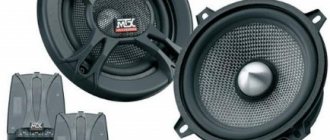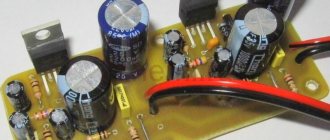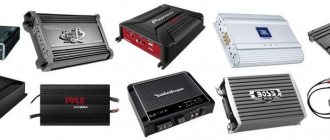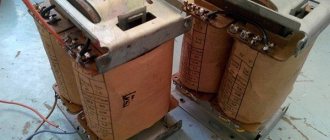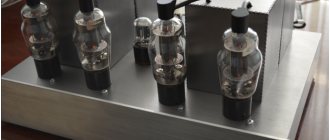Correct functioning of acoustics is impossible without an amplifier. This component is responsible for increasing the sound volume and guarantees the necessary quality when listening to music or watching movies. To select an amplifier for speakers, it is recommended to study the types of similar devices, characteristics, and also take into account the scope of application.
What happens if you choose the wrong amplifier?
Mistakes when choosing an amplifier for speakers lead to consequences. Some of them are not critical, while others interfere with the acoustics. If the power of the receiver exceeds the power of the speakers, then there will be no noticeable problems. Especially if the user is not going to use the acoustics at maximum power. In accordance with the standards, the receiver provides better sound at 55-70% of the limit.
However, no one excludes accidentally setting the maximum volume. And then the speaker diffusers are likely to fail.
If the power of the amplification device is equal to the power of the speakers, distortion is likely to occur at maximum volumes. Moreover, in this case, the receiver begins to transmit current to the speakers, leading to their gradual degradation. In advanced models, capacitors are installed to smooth out this effect.
The optimal option is the case in which the power of the amplifier is slightly less than the power of the speakers. But there is also a risk of directing current to the speakers. And if you work at low powers, it is difficult to fully realize the potential of acoustics.
How does the nature of the musical material affect the maximum permissible power of the speakers?
Speakers can suffer two types of damage - thermal and mechanical. Let's assume that a 100-watt amplifier fails and begins to produce high-frequency vibrations beyond the audible range. The lightweight tweeter voice coil can almost immediately fail due to overheating. On the other hand, suppose the woofer is constantly being overdriven by turntable rumble, too much bass, low-frequency feedback, or a combination of these factors. After some time, the moving parts of the woofer will be in a stressed state, which can lead to displacement of the voice coil axis and its wear due to friction. In particularly serious cases, the coil may fly out of the gap and hang above the magnetic system, as shown in Fig. 2.
The speaker is in good condition
Speaker is overloaded
Even not very high power can cause such damage; in the case of an ultra-low frequency signal, only 20-30 W is sufficient. Common engineering practices require professional systems to use high-pass filters to attenuate signals outside the system's bandwidth.
Main criteria for choosing an amplifier
When choosing an amplification device, you need to pay attention to several criteria: impedance, power, sensitivity and balance. These criteria are discussed in more detail below.
Impedance
Impedance is a measure of electrical resistance expressed in ohms. Most speakers have an impedance ranging from 4 to 8 ohms. The devices indicate the range with which it can work. By comparing these values, you can easily choose an option for a specific acoustic system.
It is not recommended to connect low impedance speakers to high impedance amplification devices.
Power
In amplifiers, the power parameter shows how many watts the device is capable of delivering to the connected speakers. The selection is made based on the recommended power for specific speakers. The range is indicated on the packaging of the acoustic device and provides lower and upper values. It is better to select a device whose output power is close to the upper limit of the speaker’s input power.
The characteristics of amplifying devices indicate the rated power and peak power. Attention should be paid to the nominal value, since it assumes the use of the device in standard mode.
Sensitivity
The sensitivity indicator determines the volume of the speaker when power is applied to it and is expressed in dB. Speakers with good sensitivity will provide high volume and will not require additional investment.
It is also worth considering the distance to the sound source. If at arm's length the speaker shows the required volume levels, moving away a couple of meters you can safely reduce the parameters by half.
The sensitivity of the speakers must match the parameters of the amplifier, as this turns out to be the main condition for sound control.
Amplifier to speaker balance
To obtain good sound in an audio system, it is important to maintain a balance between the parameters of the amplification device and speakers. The first one should be 60% more powerful than the speakers. This produces clear sound with minimal distortion.
If the power difference is greater, the receiver is likely to overheat and subsequently fail.
Extra options
When choosing, you need to decide in advance what specific sound you need. This can be modern multi-frequency sound or traditional soft playback.
Amplification devices can be tube or integrated. Tube models provide warm sound with minimal distortion. Suitable for lovers of old music or melodies recorded on analogue media.
Integrated circuit amplifiers are more modern and feature high-fidelity sound. Suitable for playing a variety of music, be it rock, hip-hop or club tracks.
It is better for an inexperienced user to purchase models in Moscow from popular manufacturers, bypassing the offers of online platforms like Aliexpress. However, if you wish, you can also buy models from Chinese brands at attractive prices.
Results
Our list of car amplifiers was based on various criteria: ratings and reviews from real customers, technical characteristics of models, amplifier classes, and so on. Our recommendations can help you choose the most suitable option for you.
Yes, the process of selecting a sound amplifier is difficult and long, but it is better to pay enough attention to it, because a good amplifier can provide clean, powerful sound for your car. If you want high-quality and deep sound, you don’t need to spare money, but if you don’t have enough money, you can find what you need among the budget options.
Selection of an amplifier depending on the purpose of use
All amplifiers have similar characteristics, based on which selection is made. However, depending on the purpose of use, there are additional features that are important to consider.
For home
Most home playback equipment is already equipped with a built-in amplification device, so a separate unit is not purchased so often. And the use in this case is due not so much to increasing the volume as to eliminating interference.
Recommendations to make choosing an amplifier for home acoustics easier:
- It is better to choose devices in stores where they can be checked.
- A power reserve is desirable, since operation at high power can reduce the life of the product.
- The power of each channel is 3-5 W per sq.m. Moreover, if the room is up to 15 square meters. m, you can calculate the required indicator with a lower limit of 3 W, and if it is more than 20 sq.m, then the calculation is carried out using the indicator 5 W per sq.m.
- It is advisable to choose an amplifier for home speakers with threaded connectors. They guarantee tight contact and no interference.
- If you need to get a warm sound, you can use Sum tube models at home.
For auto
Amplifiers are installed in cars to increase the power of the speakers and subwoofer. There are devices equipped with 1 to 6 channels. The single-channel model can work with high-power speakers, while the two-channel model is designed to produce stereo sound on a 2.0 speaker system.
If you need to amplify a subwoofer and two speakers in a car to work together, you will need a three-channel device with a 2.1 configuration. But the most popular among motorists are four-channel models with the ability to connect four sound sources.
Models with 5 or 6 channels expand the possibilities for organizing sound in a car, but they will require serious investment. Six-channel devices are extremely useful when organizing a 5.1 audio system with five directional speakers (including side and front) and a subwoofer in one line.
When choosing a car amplifier, you need to rely on the same criteria as when choosing household models. Kenwood is considered a popular manufacturer of car receivers.
For concert acoustics
Concert models are complex floor-standing devices with additional speakers, special effects units, and a sound timbre control unit.
It is better to select an amplifier for passive speakers after selecting the acoustics. In this case, it is extremely important to take into account the following indicators: permissible power, sensitivity, electrical resistance.
Do not use household amplification devices in the professional field. Their protective equipment is primitive, and the models themselves are not designed for intensive use at high powers from 100 watts to 500 watts or even several kilowatts.
The following factors should be considered separately:
- compliance with the area of the hall or open space where acoustics are required;
- Concert amplifiers require power reserves;
- it is advisable to take a model with a minimum value of distortion;
- frequency range – from 16 to 100,000 Hz.
Selecting speakers by sensitivity
Now let's get back to sensitivity. As mentioned at the beginning, with the same power input, different speakers can sound at different volumes. If you want to build a system in which the sound in the bass, midrange and treble ranges will be harmonious, choose speakers with approximately the same sensitivity. When selecting speakers for a 3-way, you should focus on the sensitivity measured on a signal with an amplitude of 2.83V at a distance of 1m (2.83V/1m). If another sensitivity is specified - 1W/1m - it can be easily brought to the desired dimension: - if the speaker has a resistance of 8 Ohms , then for it the sensitivity of 2.83V/1m is the same as at 1W/1m - if the speaker resistance is 4 Ohms, then for it the sensitivity of 2.83V/1m will be 3 dB more than at 1W/1m. The low-frequency speaker and the middle should have approximately the same sensitivity +/- 0.5 dB Setting up the system will not be a problem both with channel amplification and with a passive crossover. If the sensitivity of the woofer is lower than the sensitivity of the midrange by about 3 dB, then the system will have a clear dip in the bass. This situation almost always occurs if the impedance of the bass and midrange speakers is the same. It is almost impossible to find a bass speaker with the same sensitivity as the mids with the same resistance. This is due to the design features of the bass driver. An exception may be bass speakers built on a motor with a neodymium magnet. To solve the problem, you can use speakers with different impedances: LF - 4 Ohms, midrange - 8 Ohms. You can also double the number of bass drivers, this will also give the missing volume in the low frequency range. If you have channel amplification, you can adjust the entire system according to the volume of the bass, but in this case the potential of the mids and tweeters will not be fully used. In general, low sensitivity compared to the midrange is the main drawback of woofers. In addition, they are much larger and heavier than the middle ones with the same standard size. This is why real bass speakers are almost never used in loud fronts. Large-sized mids are now used as bass in systems. Some of them can play from 100-150 W, but their low-end output is negligible and these systems cannot really be considered 3-way. These are 2-way speakers with midrange speakers of different sizes. It is very easy to select tweeters based on sensitivity. As a rule, it is indicated in the instructions and is quite reliable. On standard horns it is always noticeably greater than on popular midrange drivers. Of course, this is not done by accident. The tweeter is very easy to configure for both channel and passive separation. Excess high frequencies are corrected either by the volume of the corresponding amplifier channels, or are damped by a resistor connected in series during passive separation.


